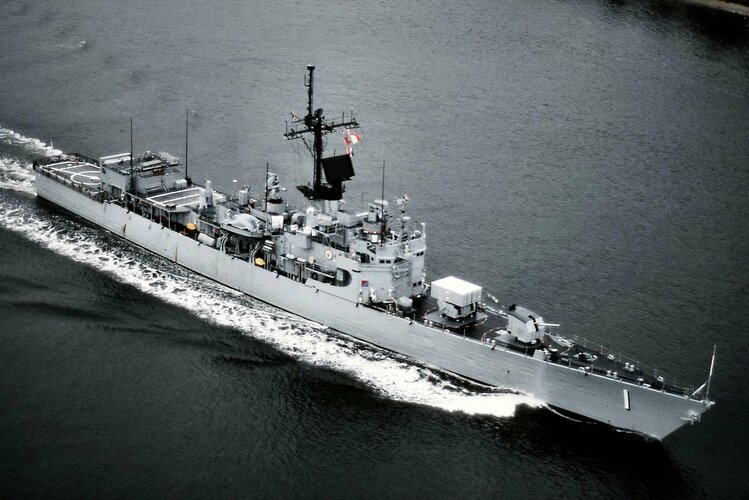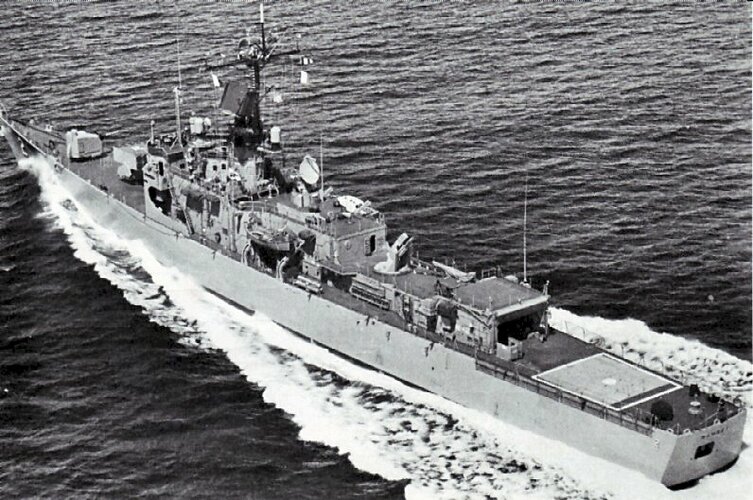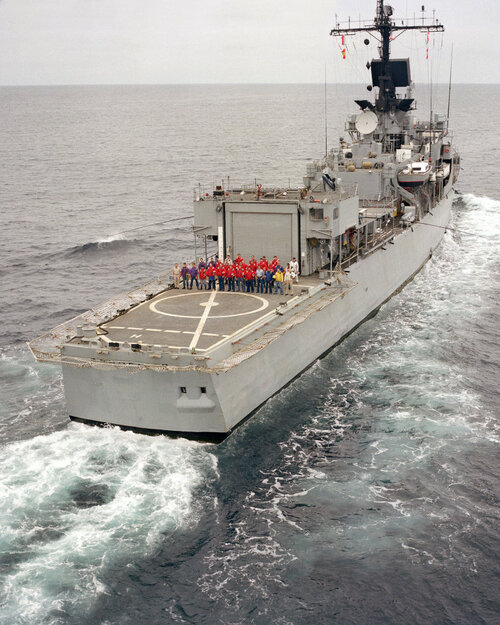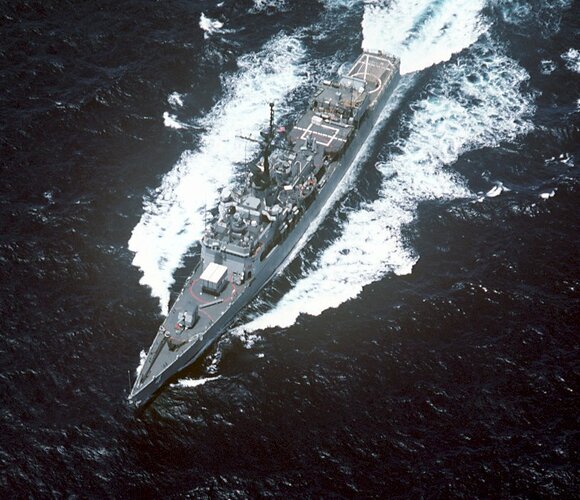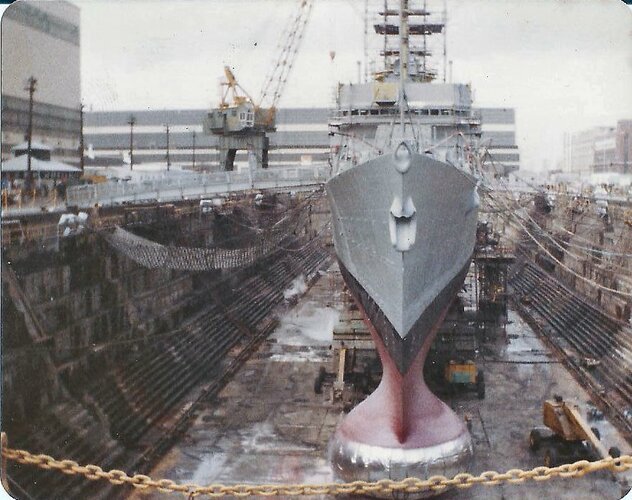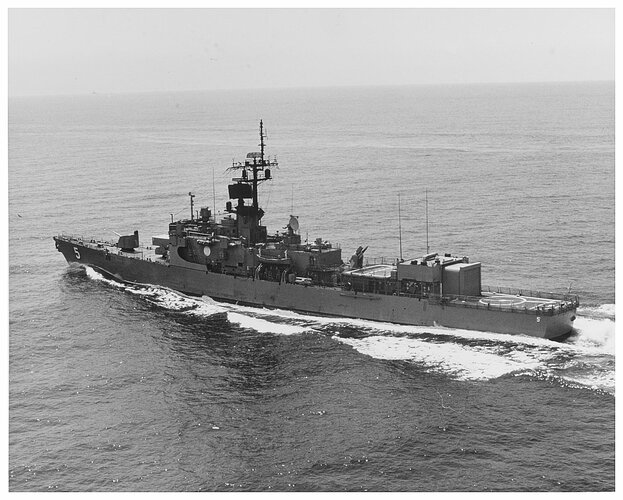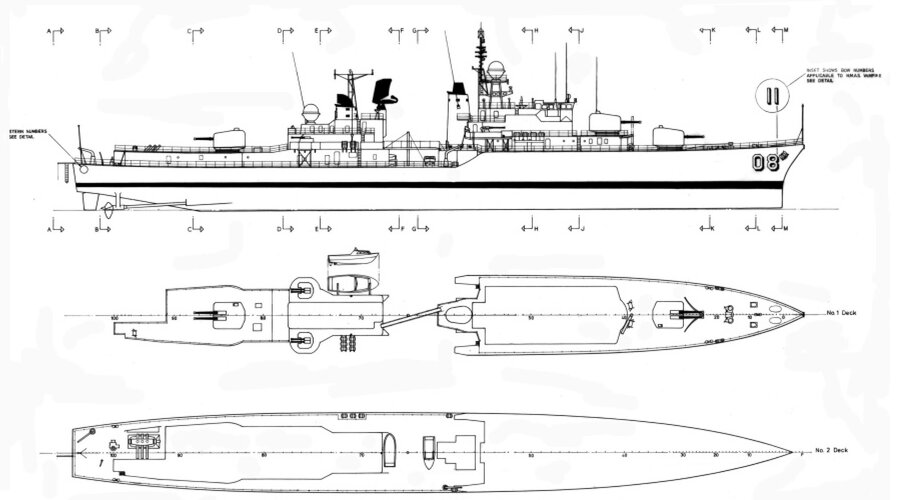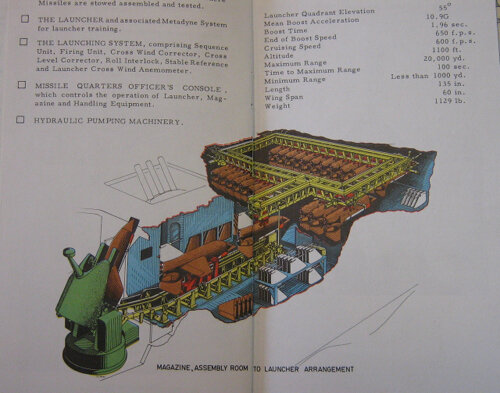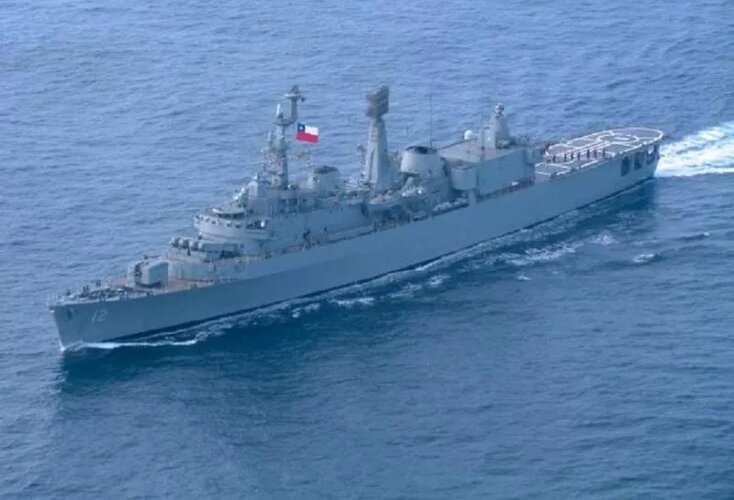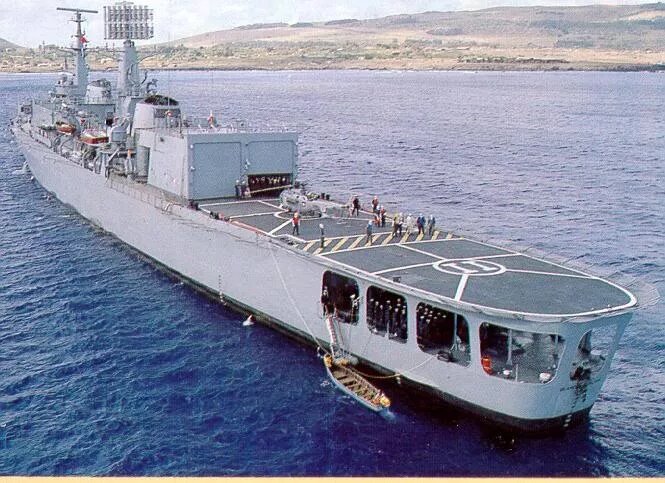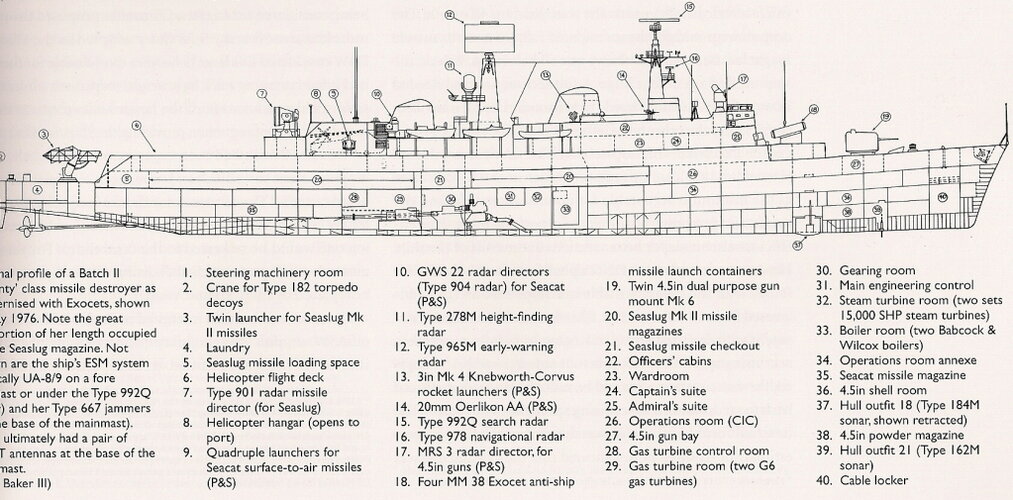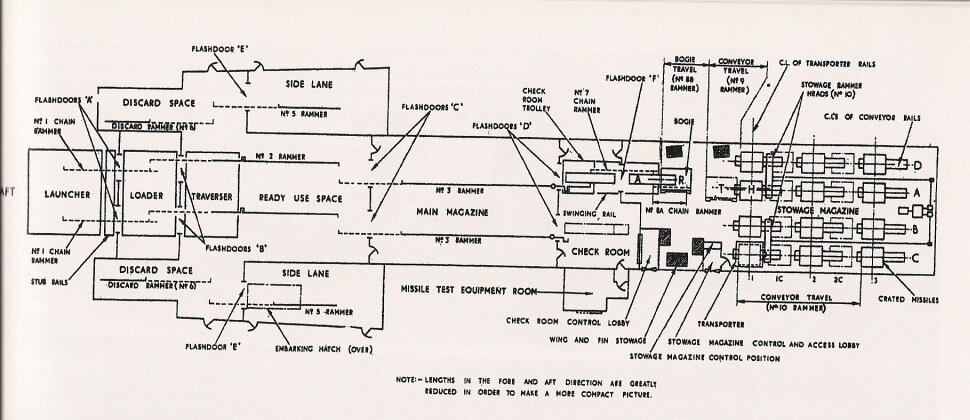Why? We ordered slow ones at the same time as wanting fleet speed ships and realising convoy was passe. Arguably they were only ordered because they were ordered and for the systems.
Six fleet speed FADEs per strike group, when a grand total of zero new destroyer-sized ships were ordered between 1945 and 1957. That is in spite of numerous attempts, all that show that such capabilities could not be fitted aboard a destroyer hull, preferred options were
Scylla and
Abdiel.
“The numbers” 4. That’s a rounding error against fleet size at the time.
There was a requirement for 10 or so Type 61s. Britain only put four into service, but they built literally zero Daring-derived FADEs, and the design studies seemed to indicate that they were not possible.
Fact remains the requirment and the thinking was already towards more fleet assets and building those would have been far, far more useful.
I don't disagree that fleet escorts would be more useful, but that requires both hindsight and knowledge of Soviet strategy that is not available in 1950. When Sverdlovs and Whiskeys are being built, few Western Admirals would believe if you told them that the Soviets intended to use them as a coastal defence force.
You are misrepresenting. I have consistently said build Type 62 or Spr Darings or FADE or even the C-D, although yes, Type 12s were far more useful as history records, so also build them instead.
This is you wrote in post #35:
All in all they seem a waste to have been built. Better more Type 12s or 2-4 Daring+/FFE type instead of them and the Type 61s.
They were modern enough to build which seems to be your logic for T41/61, there wasnt really an alternative as no other weapons existed to arm them and it took years before an alternetive propulsion set up was available.
The Type 41/61s or modern by 1950 standards. They, and the Leanders, are obsolete by 1960s standards. That is far more damning of the Leanders, since they are designed in 1959, whereas Type 41/61 have been developed since 1945, and are ordered in a panic when war is believed to be imminent.
Somewhat confusing, because I am defending the merits of the Type 41/61 in the context of 1949-53, whilst criticising the Leanders, which are very similar capabilities, in the context of 1959 onwards.
The RN didnt have “modern combatants” until Sea Wolf ships arrive, noting about half of them in the Falklands were Leanders…
And every one of those Leanders required expensive reconstructions to even be half useful combatants.
Not really, they were shunted around to one task after another, far too gun or sensor heavy for those tasks where a Leander would have been far more useful. They were got rid of early. Tells you everything.
Leander was built as a proper fleet combatant, and was significantly more sensor heavy than the Type 12 it was based on. It was expected to do limited air direction, hence had a Type 965, not quite as capable as the Types 960, 982 and 277 combination of the Type 61, but much closer than the Type 293 and 277 combination of the Type 12.
There's no tasks that require a Leander's guns that a Type 41 is too much for, of anything it gets the job done faster.
As did Type 12, any new ship proves wider advances.
Except the RN did have that foresight hence cruiser destroyer push and the thinking that culminated in 54 (noting that was basically run through in 53 if not 52).
Cruiser Destroyer was very technically risky due to the guns, but other than that there is no criticism of that series of designs that could also not apply to the Super Darings, aside from being squeezed into a 4750 ton limit. If a Mitscher breaks that limit with a pair of 5"/54 Mk 42s, SPS-8 and compact 1200 psi steam machinery, there's now hope for a ship with three 5"/70s, up to a pair of Type 984s and less advanced machinery.
They didn't apply that limit to the various Super Daring designs, were able to achieve
The fear of WW3 in the late 40s was wrong, as we know now. The “lets refight WW2” was wrong, and the absurd desire for BBs was very wrong.
A Cold War gone hot in the late 1940s early 1950s would resemble the Second World War more than any other war, given the lead times for new equipment, and vast stocks of existing wartime equipment. The fears may have been wrong, but they were a reasonable assumption at the time, and given the lead times to get new systems into service coinciding with a sudden worsening of the geopolitical situation in 1949-50 it was entirely reasonable to begin economic mobilisation based on the information that Western decision makers had at the time.
But not relevant to convoy vs fleet. One didnt happen and the other did although more hulls than was useful.
That depends how you set the requirements. Want a full daring sure but compromise a turret or something and you’ve a Gallant or G+ which is basically a fleet speed T41&61, and which nearly was built at the outset of this timeline. T41/62 began wartime but nothing was ordered til 52iirc, so all of these overlap.
Honestly with hindsight I wouldn't want to build fleet escorts until missiles were technically viable. This is for the same reason you criticise the Type 41/61. New systems are not available in time, whatever you build will be obsolete in a decade. However this is not an option available in 1950-53 when the geopolitical situation seems to dictate requirement for more hulls now.
If necessary I would gravitate more towards a length and displacement unlimited Cruiser Destroyer/Super Daring, or in a severe emergency when new systems will not enter service, a combination of repeat Didos and Battles armed with 4.5" Mk VIs, with this last option being pretty much what was planned.
Since these AD capabilities were never used, air warning may suffice, indeed it had to for the fleet because these couldn’t support it. T61 has some utility with the AD fit but T41 is literally useless.
Limited air warning was ultimately the decision taken for Battle conversions. Type 41 is still viable for Cold War roles, and can add to the anti-aircraft barrage of any group of ships it's, and would comparable to a modern destroyer, and almost certainly superior to the older wartime cruisers with their 4-inch armament.
As did Invicibles decades later, in the role of force ASW ships carrying fighters and ASW platforms.
Friedman primarily describes British Carriers performing ASW in support of US Carriers in the context of when the book was written (1986).
They dont do close escort, they are QRFs and sanitising forces, just as heavy forces had been used in WW2 and later the CAH/CVSGs were used.
Light fleet carriers were earmarked for low threat areas and trade protection, the "Heavy Carriers" were expected to attack the Soviet mainland, Northern Fleet etc. You can't deny this, they did this in exercises like Mainbrace.
None of which are remotely strike aircraft. The only one it ever got was Buccaneer (which was argued for for anti-surface threat, to convoys in the covering role). Contrary to your assertion, the RN was never equipped to hit Russian airfields. Its carriers were fighter and ASW heavy reflecting its defensive role.
They had Firebrands and later Wyverns, and the fighters could be used as, and were equipped to be used a fighter bombers. The 1952 Carrier was being designed at the time, and was expected to be capable of operating US strike aircraft, initially up to an AUW of 100,000lbs, later 70,000lbs. That rather heavily implies strike, and performing strike roles is much higher on the list of main roles than ASW.
The Heavy Carriers (and the UK would provide a third of the of the Heavy Carrier strength of the NATO strike force by D+30 in 1952) were expected to operate in high threat areas.
The emergency were assigned to the frigate conversion which as with Type 12, was the priority for fast escorts.
The War Emergency Type 62 conversions were cancelled because they did not have the necessary margins. The issues with hard war service still apply to the L and M hulls.
The RN had Battles and Cs and Weapons all kicking about in this time frame, most of which sat in reserve in this period. All could take a T61 AD fit and their gunnery would be the same or effects wise little different.
Insufficient volume without expensive reconstruction, discontinuous hulls with forecastles, hence considerable weakness to underwater detonations, plus they had torpedo batteries that would be useful dealing with Sverdlovs, any FADE reconstruction would lose them, and post war design studies had already shown that FADE capabilities could not be accommodated on destroyer hulls.
If they're in reserve there isn't the manpower to run them in peacetime. frigates are cheaper to run and maintain in a Cold War situation, and easier to build in large numbers in an emergency.
8 hulls which got retired early and never added much value. In contrast to Type 12 peers which added huge value and were used right up to and indeed past their date, plus set the basis for the follow on ships and indeed the hullform through to Type 22. Thats successful design, 41/61 a pointless dead end.
Type 12 requires considerable changes to make the Leander. Certainly as originally built they are not all that much more useful in Cold War roles than the Type 41/61. Hull form and construction is obviously very similar to Type 41/61, they're designed at the same time by the same people, and evolve from the same common frigate.
That requirement is daft. Hence why it died a year later. Its only there as a left hand right hand not coordinate thing.
It's a case of the international situation changing.
People can be more optimistic about the future of East West relations when Stalin is dead and the Korean War has been ended.
The Brooke’s illustrate just how far adrift the UK was of what was possible with first rate technology and good design. It is rather sad, but true.
Brooks are arguably much closer to Type 12/41/61 thinking, they're intended as Convoy escorts and as escorts for HUK groups, with additional limited ability to perform some destroyer roles (like Type 41). They're not intended as fleet escorts.

